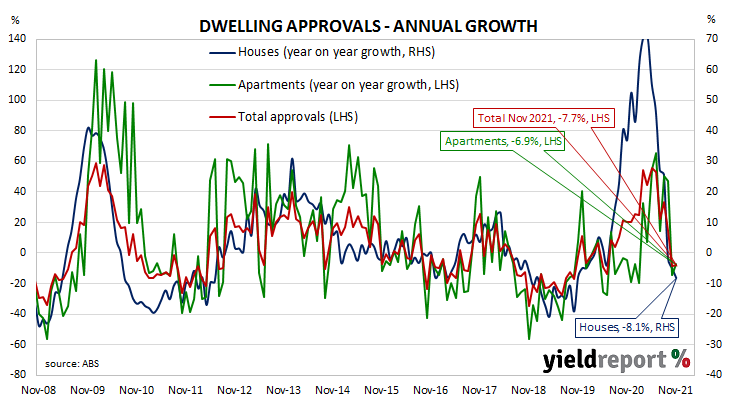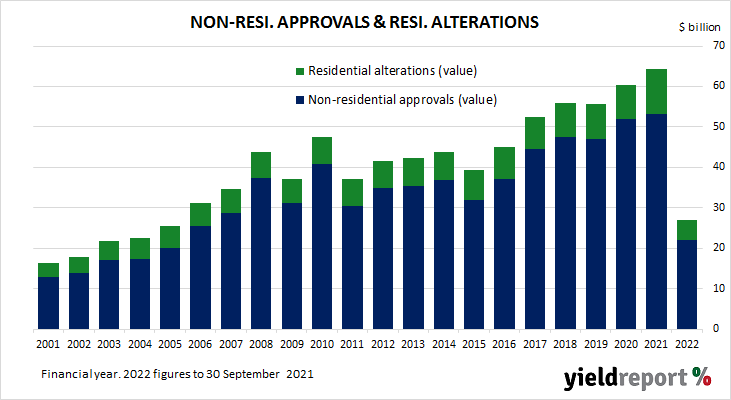Summary: Home approval numbers up 3.6% in November; slightly larger than 3.0% expected; down 7.7% on annual basis; “not necessarily beginning of upward trend”; ANZ: approvals have some chance of holding up but “bigger risks” looking further out; NAB: “further declines likely”; house approvals up 1.7%, apartment up 7.5%; non-residential approvals up 28.3% in dollar terms, residential alterations down 0.8% over month.
Building approvals for dwellings, that is apartments and houses, had been heading south since mid-2018. As an indicator of investor confidence, falling approvals had presented a worrying signal, not just for the building sector but for the overall economy. However, approval figures from late-2019 and the early months of 2020 painted a picture of a recovery taking place, even as late as April of that year. Subsequent months’ figures then trended sharply upwards before easing somewhat in the June and September quarters of 2021.
The Australian Bureau of Statistics has released the latest figures from November and total residential approvals increased by 3.6% on a seasonally-adjusted basis. The rise over the month was slightly larger than the 3.0% increase which had been generally expected and in contrast with October’s 13.6% drop. Total approvals fell by 7.7% on an annual basis, up from the previous month’s revised figure of -8.2%. Monthly growth rates are often volatile.
“While this was stronger than expected, it is not necessarily the beginning of an upward trend,” said ANZ senior economist Adelaide Timbrell.
Commonwealth Government bond yields rose on the day. By the close of business, the 3-year ACGB yield had added 2bps to 1.29% while 10-year and 20-year yields each finished 6bps higher at 1.95% and 2.48% respectively.
Timbrell thinks approval numbers have some chance of holding up given the popularity of working from home and higher savings rates in the presence of reduced consumer spending. However, “there are bigger risks to building approvals looking further out, in particular higher interest rates.”
NAB economist Taylor Nugent was more pessimistic. “Further declines [from the April peak] are likely given the ongoing fall in loan approvals for new construction.”
Approvals for new houses increased by 1.7% over the month after rising by 3.7% in October after revisions. On a 12-month basis, house approvals were 8.1% lower than they were in November 2020, down from October’s comparable figure of -4.9%.
Apartment approval figures are usually a lot more volatile and November’s total rose by 7.5% after a 36.5% drop in October. The 12-month growth figure improved from October’s revised rate of -14.6% to -6.9%.
Non-residential approvals increased by 28.3% in dollar terms over the month and by 27.9% on an annual basis. Figures in this segment also tend to be rather volatile.
Residential alteration approvals declined by 0.8% in dollar terms over the month but were 11.4% higher than in November 2020.



